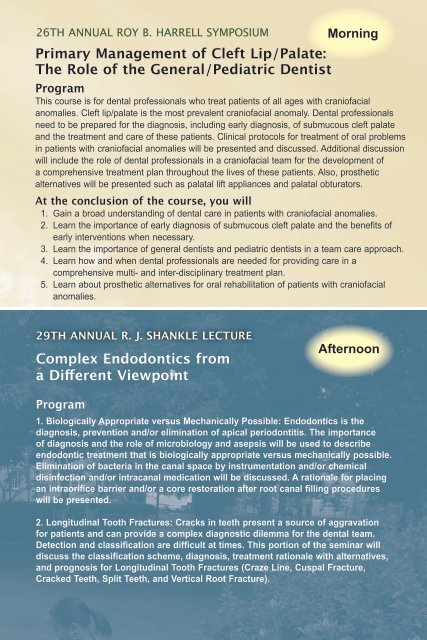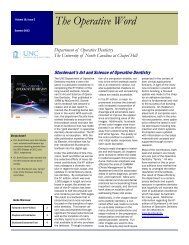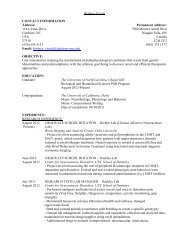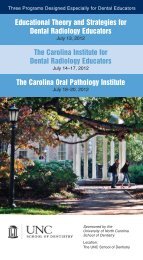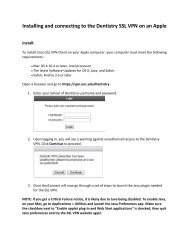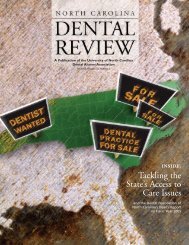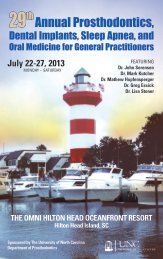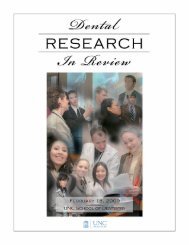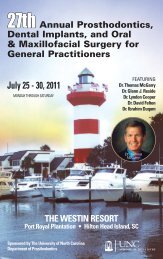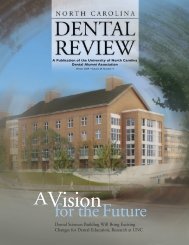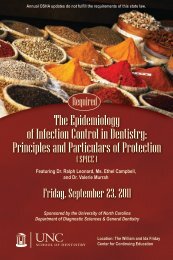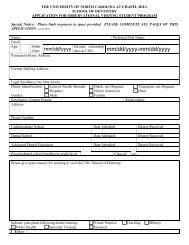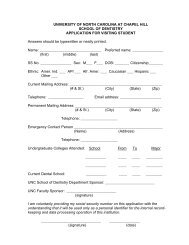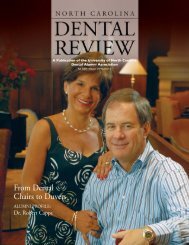R. J. ShAnkLE LECTuRE Roy b. hARRELL SyMPoSiuM
R. J. ShAnkLE LECTuRE Roy b. hARRELL SyMPoSiuM
R. J. ShAnkLE LECTuRE Roy b. hARRELL SyMPoSiuM
You also want an ePaper? Increase the reach of your titles
YUMPU automatically turns print PDFs into web optimized ePapers that Google loves.
26th Annual roy b. Harrell SympoSium Morning<br />
Primary Management of Cleft Lip/Palate:<br />
The Role of the General/Pediatric Dentist<br />
Program<br />
This course is for dental professionals who treat patients of all ages with craniofacial<br />
anomalies. Cleft lip/palate is the most prevalent craniofacial anomaly. Dental professionals<br />
need to be prepared for the diagnosis, including early diagnosis, of submucous cleft palate<br />
and the treatment and care of these patients. Clinical protocols for treatment of oral problems<br />
in patients with craniofacial anomalies will be presented and discussed. Additional discussion<br />
will include the role of dental professionals in a craniofacial team for the development of<br />
a comprehensive treatment plan throughout the lives of these patients. Also, prosthetic<br />
alternatives will be presented such as palatal lift appliances and palatal obturators.<br />
At the conclusion of the course, you will<br />
1. Gain a broad understanding of dental care in patients with craniofacial anomalies.<br />
2. Learn the importance of early diagnosis of submucous cleft palate and the benefits of<br />
early interventions when necessary.<br />
3. Learn the importance of general dentists and pediatric dentists in a team care approach.<br />
4. Learn how and when dental professionals are needed for providing care in a<br />
comprehensive multi- and inter-disciplinary treatment plan.<br />
5. Learn about prosthetic alternatives for oral rehabilitation of patients with craniofacial<br />
anomalies.<br />
29th Annual R. J. Shankle Lecture<br />
Complex Endodontics from<br />
a Different Viewpoint<br />
Afternoon<br />
Program<br />
1. Biologically Appropriate versus Mechanically Possible: Endodontics is the<br />
diagnosis, prevention and/or elimination of apical periodontitis. The importance<br />
of diagnosis and the role of microbiology and asepsis will be used to describe<br />
endodontic treatment that is biologically appropriate versus mechanically possible.<br />
Elimination of bacteria in the canal space by instrumentation and/or chemical<br />
disinfection and/or intracanal medication will be discussed. A rationale for placing<br />
an intraorifice barrier and/or a core restoration after root canal filling procedures<br />
will be presented.<br />
2. Longitudinal Tooth Fractures: Cracks in teeth present a source of aggravation<br />
for patients and can provide a complex diagnostic dilemma for the dental team.<br />
Detection and classification are difficult at times. This portion of the seminar will<br />
discuss the classification scheme, diagnosis, treatment rationale with alternatives,<br />
and prognosis for Longitudinal Tooth Fractures (Craze Line, Cuspal Fracture,<br />
Cracked Teeth, Split Teeth, and Vertical Root Fracture).


